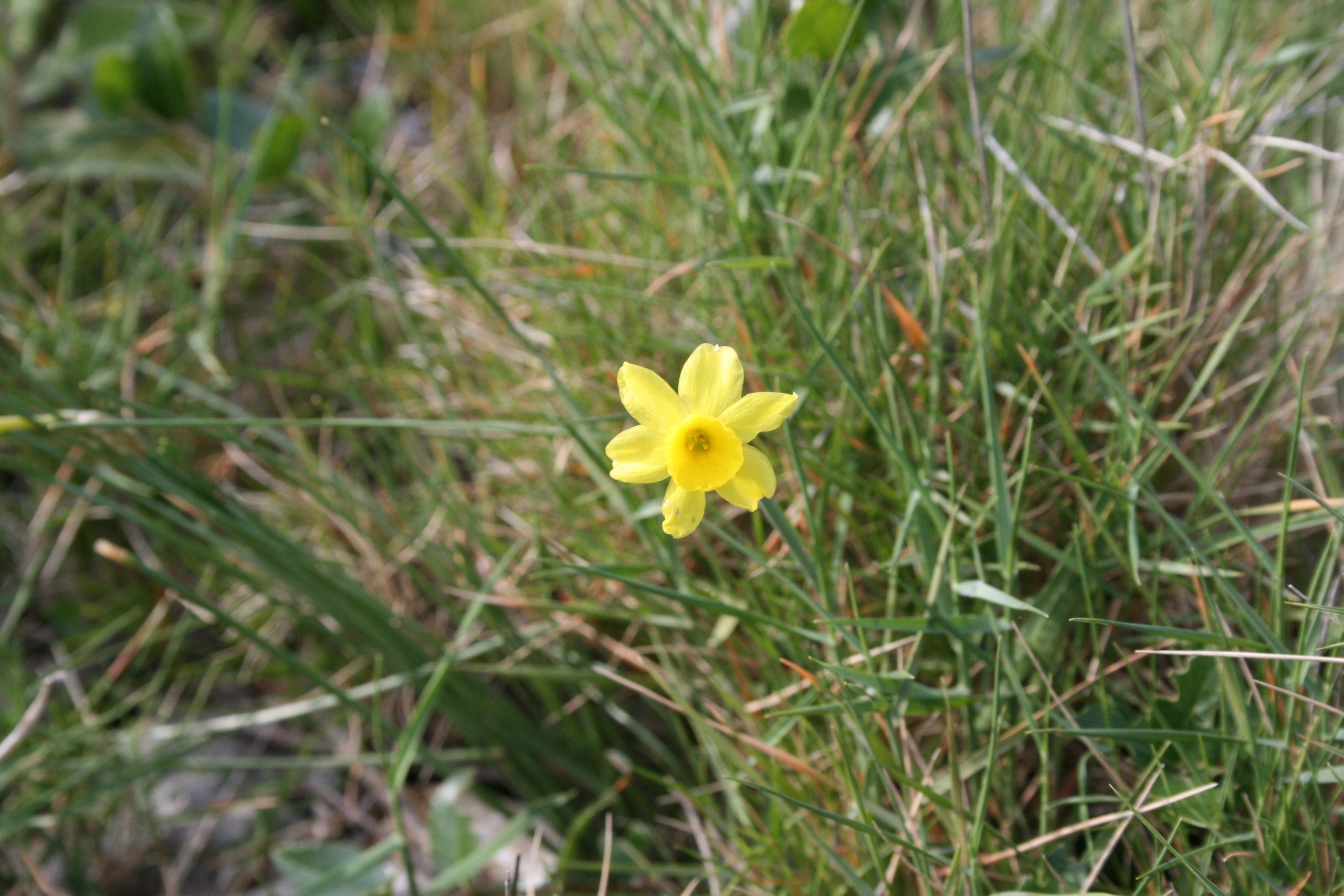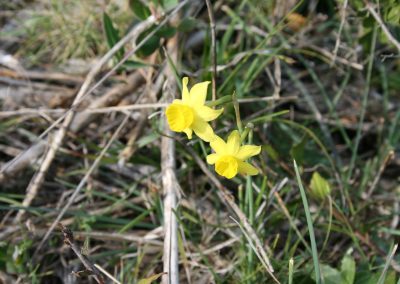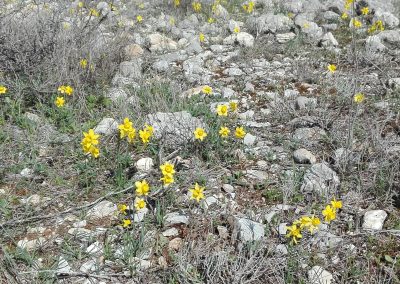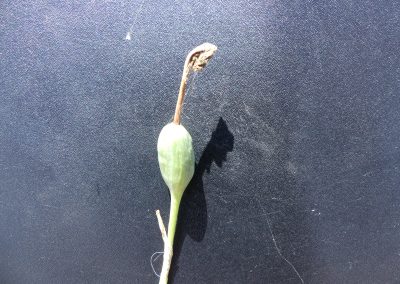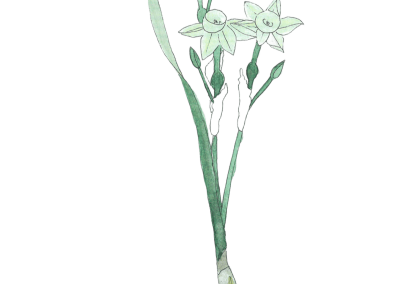Narcissus assoanus
Scientific description
Taxon: Narcissus assoanus
Class: Liliopsida
Subclass: Liliidae
Order: Asparagales
Family: Amaryllidaceae
Common name: Asso’s daffodil / Small yellow daffodil
Origin:
Southern Europe, mainly southern France, Spain, and northeastern Africa.
Description:
Small perennial bulbous plant, 10–25 cm tall. Narrow, linear, blue-green leaves. Flowers March–May, 1–3 bright yellow flowers per stem, ~2 cm, strongly fragrant, spreading tepals, short corona. Grows in dry grasslands, calcareous slopes, open fallow land, sunny roadsides. Drought-tolerant, adapted to poor well-drained soils.
Propagation:
By seeds (slow development) or vegetative division of bulbs after flowering.
Ecology:
Typical of open Mediterranean or sub-Mediterranean habitats. Supports early pollinating insects. Drought-tolerant.
Uses:
Ornamental; suitable for rock gardens or naturalized areas. Formerly used medicinally.
Threats:
Locally threatened by intensive farming, overgrazing, and urban development. Protected in some regions.
Taxon: Narcissus assoanus
Classe: Liliopsida
Sous-classe: Liliidae
Ordre: Asparagales
Famille: Amaryllidacées
Nom commun: Narcisse d’Asso / Petit narcisse jaune
Origine:
Sud de l’Europe, principalement sud de la France, Espagne, nord-est de l’Afrique.
Description:
Petite plante bulbeuse vivace, 10–25 cm. Feuilles linéaires, étroites, bleu-vert. Floraison mars–mai, 1–3 fleurs jaune vif par tige, ~2 cm, très parfumées, tépales étalés, courte couronne. Milieux secs: pelouses, coteaux calcaires, friches, bords de chemins ensoleillés. Résistante à la sécheresse.
Propagation:
Par graines (lent développement) ou division végétative des bulbes après floraison.
Écologie:
Espèces typiques des milieux ouverts méditerranéens ou subméditerranéens. Favorise les insectes pollinisateurs printaniers. Résistante à la sécheresse.
Utilisation:
Ornementale pour rocaille ou jardin naturel. Ancienne utilisation médicinale.
Menace:
Localement menacée par agriculture intensive, surpâturage, urbanisation. Protégée dans certaines régions.
Taxon: Narcissus assoanus
Clasă: Liliopsida
Subclasă: Liliidae
Ordin: Asparagales
Familie: Amaryllidaceae
Denumire populară: Narcisă de Asso / Mică narcisă galbenă
Origine:
Sudul Europei, în special sudul Franței, Spania și nord-estul Africii.
Descriere:
Plantă bulbică perenă, 10–25 cm, frunze liniare, înguste, verde-albăstrui. Florile apar primăvara (martie–mai), 1–3 flori galben-intens, ~2 cm, foarte parfumate, tepaluri deschise, coroană scurtă. Crește în pajiști uscate, versanți calcaroși, terenuri în paragină, margini însorite de drumuri. Rezistentă la secetă.
Propagare:
Prin semințe (dezvoltare lentă) sau divizarea bulbului după înflorire.
Ecologie:
Specie tipică a habitatelor deschise mediteraneene sau submediteraneene. Susține polenizatorii de primăvară. Rezistentă la secetă.
Utilizare:
Ornamentală pentru grădini de stâncă sau spații naturalizate. Folosită în trecut în medicina tradițională.
Amenințări:
Amenințată local de agricultura intensivă, pășunatul excesiv și urbanizare. Protejată în unele regiuni.
Ταξινόμηση: Narcissus assoanus
Κλάση: Liliopsida
Υποκλάση: Liliidae
Τάξη: Asparagales
Οικογένεια: Amaryllidaceae
Κοινή ονομασία: Νάρκισσος του Άσσο / Μικρός κίτρινος νάρκισσος
Προέλευση:
Νότια Ευρώπη, κυρίως νότια Γαλλία, Ισπανία, βορειοανατολική Αφρική.
Περιγραφή:
Μικρό πολυετές βολβώδες φυτό, 10–25 εκ., φύλλα στενά, γραμμικά, γαλαζοπράσινα. Άνθη Μάρτιο–Μάιο, 1–3 έντονα κίτρινα, ~2 εκ., πολύ αρωματικά, τεπάλια απλωμένα, στεφάνη κοντή. Αναπτύσσεται σε ξηρούς λειμώνες, ασβεστολιθικές πλαγιές, φρυγανικές εκτάσεις, ηλιόλουστες άκρες δρόμων. Ανθεκτικό στην ξηρασία.
Διάδοση:
Με σπόρους (αργή ανάπτυξη) ή διαίρεση βολβών μετά την άνθιση.
Οικολογία:
Τυπικό είδος ανοιχτών μεσογειακών ή υπομεσογειακών ενδιαιτημάτων. Υποστηρίζει ανοιξιάτικους επικονιαστές. Ανθεκτικό στην ξηρασία.
Χρήσεις:
Καλλωπιστικό για βραχόκηπους ή φυσικούς κήπους. Παλιότερα χρησιμοποιήθηκε στη λαϊκή ιατρική.
Απειλές:
Τοπικά απειλείται από εντατική γεωργία, υπερβόσκηση και αστικοποίηση. Προστατεύεται σε ορισμένες περιοχές.
Creative writing inspired by Narcissus assoanus
The narcissus of the garrigues and the breath of memory
In a small village nestled in the sunny hills of southern France, lived an old lady named Claire. She had once been a lively, wise woman, but time, mercilessly, had gradually erased her memories. Every day, she woke up with a little less clarity, a little more confusion. Doctors called it Alzheimer's disease, an affliction that gradually steals memory, personality and sometimes even the soul.
Her children, exhausted from caring for her, were desperate for a cure, for hope, but conventional treatments seemed to offer only temporary relief. One autumn afternoon, while walking alone in the nearby garrigue, Claire suddenly stopped in front of a plant she had never noticed before. It was a delicate flower with white and yellow petals, growing among thorn bushes and dry grasses.
This plant, she knew instinctively, was a narcissus of the garrigues, a rare species that only grew in specific conditions, where the soil was poor and temperatures dry. Claire bent down to touch the petals. As she touched the flower, a strange shiver ran through her body. A gentle breeze seemed to blow over her, but it wasn't just the air that caressed her; it was as if an ancient, benevolent breath was seeping into her spirit.
She stood up, her heart pounding, as if something distant had just resurfaced. She knew this flower. She recognized it. She suddenly remembered the afternoons she'd spent with her mother, roaming the daffodil fields as a child, laughing out loud. That feeling of light, warmth, purity, all seemed to come back to her in an instant.
The next morning, Claire woke up with a strange sense of clarity. The usual confusions had disappeared. She wasn't cured, no, but something in her had changed. Her eyes were sharper, and her memories, though fragmented, were gradually coming back, like a jigsaw puzzle whose pieces were beginning to reassemble. She hadn't forgotten the names of her children or her friends, and scenes from her youth flashed through her mind like sunshine after rain.
Intrigued, her daughter Lucie, who knew the plant by name only, decided to talk to the doctor. After analyses and tests, he couldn't explain the phenomenon precisely, but he did note that Claire seemed noticeably more present, more lucid. The effects of her illness seemed to be lessening. He suggested that the natural environment and this “magical contact” with the narcissus flower had had a calming effect, a catalyst for memory and emotion.
Weeks went by, and Claire continued to visit the narcissus regularly. With each encounter, she felt her memories anchored a little more deeply within her. It wasn't a miracle cure, but a healing. A link with nature, with her past, that revived her tired spirit.
In time, the old lady rediscovered some of the essence she'd thought she'd lost. Daffodils, simple and beautiful, had become her remedy, not by magic, but by that sweetness that only nature can offer, a return to her roots. And in the golden light of autumn afternoons, Claire, surrounded by her loved ones, rediscovered a taste for life and hope in the memories of a bygone era.


